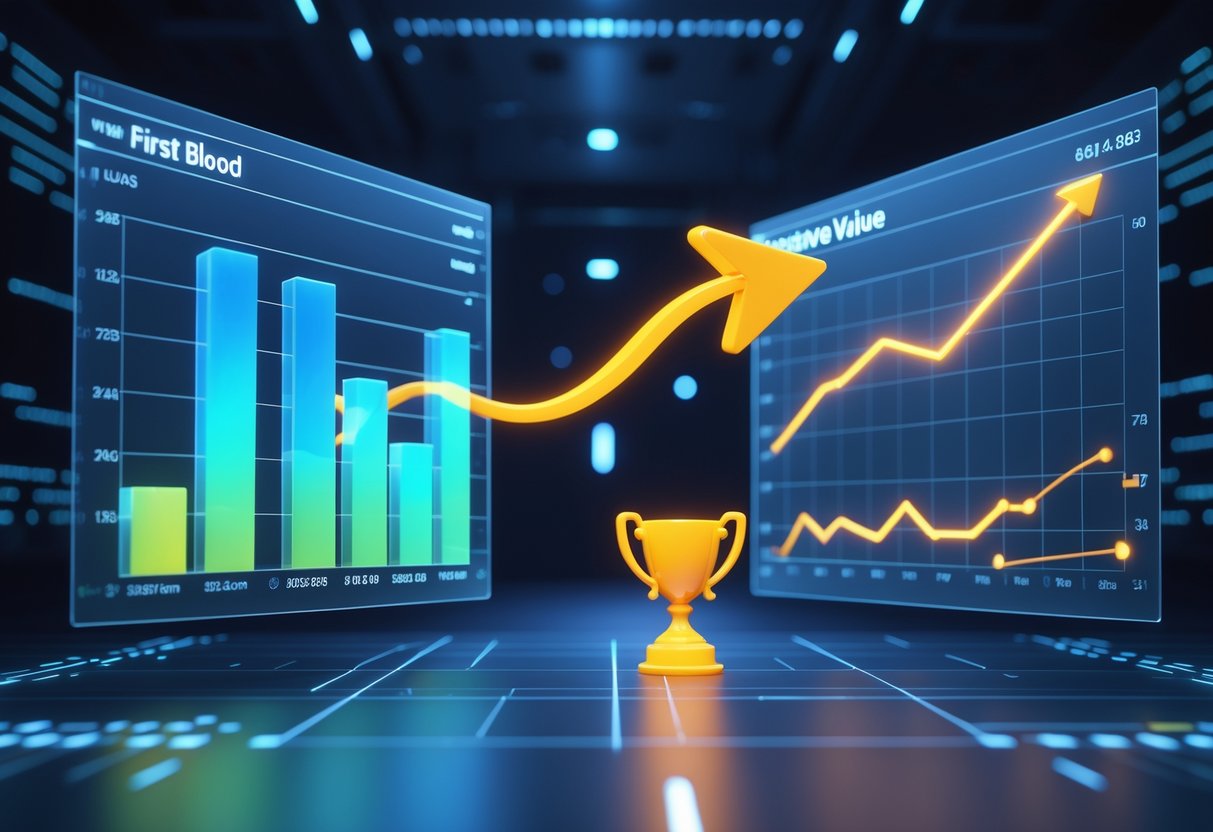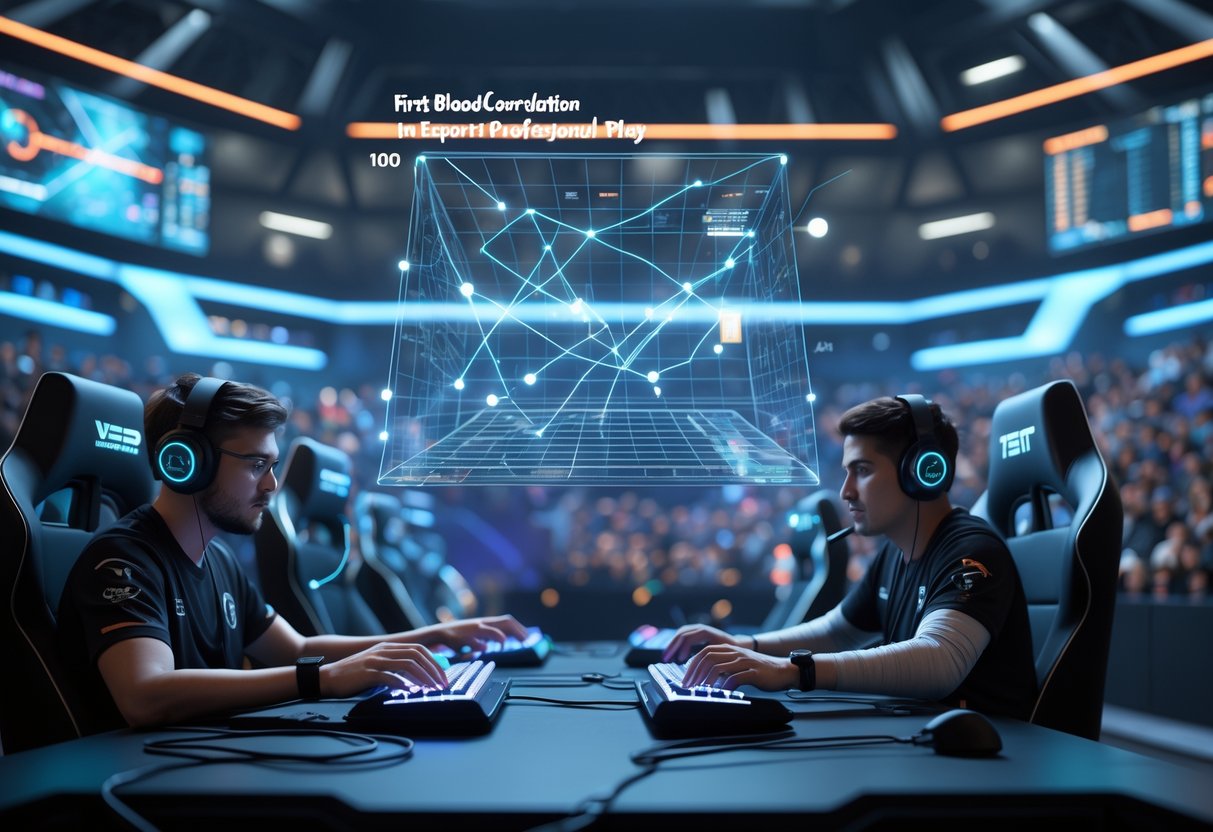First Blood Correlation: Understanding Links and Impact in Competitive Play
Updated On: August 23, 2025 by Aaron Connolly
Defining First Blood Correlation
First blood correlation looks at how often getting the first kill in a match leads to winning the whole game. Analysts use correlation coefficients like Pearson’s r to see if teams that get first blood win more often than you’d expect by chance.
First Blood Outcomes in Competitive Games
First blood is just the first elimination in team-based games. You’ll see it in almost every big esport—League of Legends, Counter-Strike, Valorant, you name it.
Landing first blood gives teams a real psychological and strategic edge right away. Teams who grab it usually get a quick burst of momentum and more control over the map.
Key benefits include:
- Early economy boost from kill rewards
- Numerical advantage in team fights
- Psychological pressure on opponents
- Strategic positioning opportunities
First blood usually happens in the opening minutes. Pro teams break down these early fights to spot patterns and craft counter-strats.
Coaches keep tabs on first blood stats to measure team aggression and early-game execution. This data reveals how well teams handle the start of a match.
Correlation Versus Causation in Match Analysis
Statistical correlation tells us how closely first blood links to winning. Correlation coefficients run from -1 to +1, with higher numbers meaning a stronger positive relationship.
Pearson’s r is the go-to for first blood correlation in esports. Numbers above 0.5? That’s a moderate correlation. Above 0.7? Now you’re talking strong.
But correlation doesn’t mean causation. First blood might line up with wins because:
- Strong teams naturally get both first kills and wins
- Early leads snowball as matches go on
- Psychological pressure shifts after the first kill
We really need to ask: do teams win because they get first blood, or do good teams just tend to do both? Proper analysis takes into account team skill, map quirks, and the rules of each game.
Analysts now look at first blood correlation alongside other early-game stats to get a full picture of performance.
Measuring the Correlation Coefficient
The correlation coefficient shows how strong and which way the relationship runs between two things, from -1 to +1. Pearson’s r fits best for normal, continuous data, while Spearman’s rho works for ranked lists or non-normal data.
Understanding Pearson’s r
Pearson’s r is the most popular correlation coefficient in research. It measures how two continuous, normally distributed variables move together.
The value sits between -1 and +1. If you hit +1, you’ve got a perfect positive relationship. -1 is a perfect negative one. Zero just means no clear link.
| Pearson’s r Value | Strength |
|---|---|
| 0.9 to 1.0 | Very Strong |
| 0.7 to 0.89 | Strong |
| 0.5 to 0.69 | Moderate |
| 0.3 to 0.49 | Weak |
| 0.1 to 0.29 | Very Weak |
| 0 | No Correlation |
One thing to keep in mind: statistical significance isn’t the same as strength. You can have a correlation of 0.31 with a p-value under 0.001, but it’s still a weak relationship.
Pearson’s r only works well if your data is normally distributed. If not, or if you’ve got weird outliers, go for a rank-based method.
Spearman’s Rho and Nonparametric Relationships
Spearman’s rho (rs) uses ranked data instead of raw numbers. It’s the better pick if your data isn’t normal or has outliers that could mess up Pearson’s r.
This coefficient checks how the ranks line up. It’s good for monotonic relationships—when two things tend to move together, even if not in a straight line.
Spearman’s rho is great for ordinal data, like survey answers or player rankings. It’s also safer with small sample sizes or messy data.
The scale is the same as Pearson’s r. Closer to +1 or -1 means a stronger link. Near zero? Not much association.
Quick tip: If you’re unsure about your data, start with Spearman’s rho—it’s more forgiving.
Alternative Statistical Approaches to First Blood Impact
Other statistical methods can uncover patterns in first blood data that regular analysis might overlook. Kendall’s tau shines with ranked gaming data, and F tests let us compare significance across several metrics at once.
Kendall’s Tau for Ranked Data
Kendall’s tau is handy when we’re looking at first blood’s effect on ranked performance. It handles tied values better than most correlation methods.
This method works well when you’re digging into player or team rankings. Unlike Pearson, Kendall’s tau doesn’t expect a straight-line relationship—pretty important in esports, where progress can jump in steps.
Analysts like this method for bracket analysis. It fits the “ranked” nature of tournaments. You’ll see correlation values from -1 to 1, which keeps things simple.
Comparing F Test and Other Significance Measures
The F test gives us a different angle on first blood’s importance compared to regular correlation checks. We use it to look at variance between groups—those with and without first blood.
It helps spot if first blood creates statistically significant differences across several metrics at once. Mixed-effects models work with F tests to handle repeated measures in the same match or event.
T-tests can miss subtle patterns that F tests catch. The F statistic compares what the model explains versus what it doesn’t, so we get a clearer sense of first blood’s real impact. That’s especially useful when you want to account for team skill or map differences.
Role of First Blood by Lane and Position
Different lanes don’t contribute equally to first blood. Bottom lane leads in early kills, probably because more players fight there at the start. Supports actually snag a lot of these first bloods, even though they don’t build for damage.
Comparisons Across Top, Mid, and Bottom Lane
Bottom lane racks up the most first blood kills at every skill level. That’s because four players often scrap there right away.
The 2v2 setup creates all kinds of kill chances. If junglers show up, it gets even wilder.
Top lane sees fewer first bloods but, oddly enough, those kills lead to higher win rates. Solo lane wins just snowball harder.
Mid lane falls somewhere in the middle. Mid laners can roam, so their first blood impact is less predictable.
Here’s a rough breakdown:
| Lane Position | First Blood % | Win Rate After |
|---|---|---|
| Bottom Lane | 45-50% | 58-62% |
| Top Lane | 25-30% | 62-65% |
| Mid Lane | 20-25% | 60-63% |
Support Contributions to Early Lead
Supports grab more first bloods than you’d expect, even without building much damage. Their early-game abilities often land the final hit.
Most supports deal a surprising amount of damage early on. Before everyone gets tanky, their skills can really hurt.
Execute abilities let supports finish off low-health enemies. Champs like Pyke or Thresh are notorious for this in bottom lane brawls.
The support role helps most when they survive the fight. If a support dies, they can’t ward, protect, or keep pressure on objectives.
When junglers gank bottom, supports often end up with first blood. The chaos lets them stay safe and still deal enough damage to claim the kill.
Win Rate and Predictive Value of First Blood

First blood gives a team a big boost—pro League of Legends data says teams that get it win about 60% of the time. Player skill and ranking really change how much this early advantage helps in actually winning matches.
Analysing Win% Post-First Blood
Pro League of Legends matches have some eye-opening stats on first blood. Teams that get it win around 60% of the time—a solid 10% above the usual 50/50 split.
This isn’t just luck. First blood gives instant advantages that add up as the match goes on. Teams get 400 gold and XP, which means a quick power boost.
Statistically, there’s a moderate positive correlation between first blood and winning. The coefficient usually sits between 0.3 and 0.5 in different leagues.
But first blood doesn’t lock in a win. Pro teams with steady nerves can bounce back from early losses. The real difference comes from how teams use that lead—objective control and map pressure matter more than just the gold.
Data from Oracle’s Elixir shows first blood teams also rack up more kills, assists, and better objective control. Sometimes, those follow-up stats matter even more than the first kill itself.
Influence of Player Rank and Elo
Player rank has a huge effect on how much first blood predicts a win. Higher-ranked players know how to turn an early lead into a victory.
Platinum and above: First blood win rates climb to around 65%. Skilled players can snowball with smart plays and team coordination.
Gold and below: Win rates stay around 55-58%. Lower ranks struggle to keep their lead, so matches can swing wildly even after an early kill.
Pearson’s r gets stronger at higher skill levels. Pros show about 0.4, but in casual games it might only be 0.25.
Jungle players have the best first blood win rates when they solo the kill. Solo jungle first bloods show a 64.9% win rate, compared to 60% for assisted lane kills.
Regional quirks show up too. Korean and Chinese pro leagues have slightly higher correlations, probably because they play more aggressively early and focus on objectives.
Assisted Versus Solo First Blood

Solo first blood means one player gets the kill by themselves. Assisted first blood happens when teammates help out. The gold split and strategy behind each one change how teams play the early game and fight for map control.
Gold Distribution and Team Strategies
Solo first blood drops the full 450 gold on one player. That’s a huge personal edge and can quickly lead to lane dominance.
A solo killer heads back to lane with better items. That means stronger trades and easier farming. Top laners, in particular, love solo kills—they can rush defensive or damage items.
Assisted first blood splits like this:
- Killer gets 300 gold
- Each assist gets 150 gold
- Total team gold still adds up to 450
Teams often plan assisted first bloods with jungle ganks. The jungler helps secure the kill and gets a gold boost for early items. This spreads the advantage instead of piling it all on one player.
Mid lane ganks are especially effective for assisted first bloods. Both the mid laner and jungler get closer to their first power spikes.
Implications for Roaming and Map Pressure
Solo first blood usually happens during the laning phase, and it rarely involves outside help.
Players who manage solo kills often pick strong 1v1 champions or just outplay their opponents.
That early gold from solo first blood lets them get aggressive. If the mid laner gets fed, they’re suddenly showing up in other lanes, creating pressure everywhere.
One early kill can snowball into a map-wide headache for the enemy team.
Assisted first blood really shakes up team dynamics:
- Teams start making more coordinated plays
- Junglers get involved early
- Support roaming becomes a lot more impactful
When teams pull off assisted first blood, they often keep working together. That shared win builds momentum for more ganks and better control over objectives.
Assisted first blood also points to solid team communication.
Teams that coordinate early kills usually stay sharp with map awareness, and that leads to better rotations and team fights later.
First Blood Correlation in Esports and Professional Play

The connection between first blood and winning changes a lot between casual games and pro tournaments.
Research says pro teams win about 55% of games after getting first blood, but in amateur play, the link is weaker.
Differences Between Solo Queue and Esports
Most amateur players don’t really plan out first blood. They just run into early kills by accident, without much team support or follow-up.
Professional teams take a very different approach. They pour resources into securing early leads with careful planning and timing.
Solo Queue Characteristics:
- Outcomes are unpredictable
- Individual skill rules
- Teamwork is hit or miss
- First blood often comes from random fights
Professional Play Features:
- Strategic planning is the norm
- Teams invest early for an advantage
- Rotations for kills are coordinated
- Mind games start right away
The gap in skill between teams matters more than first blood itself. Stronger teams pick up both early kills and wins just by being better.
In pro matches, teams sometimes throw multiple players at stopping enemy first blood. That kind of defense shows how much pros value the early game.
Sample Sizes and Statistical Support
Most studies on this topic just don’t have enough data.
Reddit threads throw around 55-45 win rates, but those numbers aren’t really backed by solid stats.
Pro tournament data gives us better samples than solo queue, but we still need things like f test analysis to know if the correlations actually mean anything.
Current Research Limitations:
- Tournament samples are often too small
- Data mixes all skill levels
- Control variables are missing
- No long-term studies
Psychology muddies the waters. Teams that get first blood usually play with more confidence, while the others might tilt or make risky moves.
Support players have a huge impact on first blood timing in pro games. They set up vision and engage way better than most amateur players.
It gets tricky when team skill affects both first blood and winning overall. Without the right controls, it’s tough to tell if first blood really matters.
Visualising and Interpreting Correlation

Understanding correlation patterns gets easier when you look at scatterplots. Each point on the plot tells a bit about how two things relate.
The way the points line up shows if the relationship is a straight line or something messier.
Scatterplots and Trends
Scatterplots make it simple to spot correlation strength.
Each dot stands for a match or player. When the dots crowd around a line, that’s a strong correlation.
Strong positive correlations (r = 0.7 to 1.0) look like a staircase going up. Strong negative ones (r = -0.7 to -1.0) drop off quickly.
Moderate correlations (r = 0.3 to 0.7) have dots spread wider, but there’s still a trend. Weak ones (r = 0.1 to 0.3) just scatter all over.
Quick tip: If the dots are packed tight, there’s probably a reliable relationship.
You can get a sense of correlation just by eyeballing the plot. Tight clusters mean a strong link, while scattered dots usually mean you can’t trust it for predictions.
Linear Versus Non-linear Patterns
Linear correlations make neat, straight lines on scatterplots. Most esports stats fall into this category. More kills usually means more damage—pretty direct.
Non-linear patterns bend or curve on the plot. Correlation coefficients won’t catch these at all. A player’s performance might climb, then hit a ceiling at higher ranks.
Heads up: Correlation coefficients only see straight lines. Curves need other tools.
Sometimes you get U-shaped or upside-down U-shaped patterns in esports data. Mid-tier players might act differently than newbies or pros. Standard correlation just misses these.
Always check the scatterplot before trusting the numbers. The dots tell the real story.
Common Pitfalls and Misconceptions

Teams sometimes put way too much stock in first blood as a match predictor. They forget about all the other stuff that actually decides games.
This kind of tunnel vision can lead to bad strategies and wild expectations.
Overestimating the Importance of First Blood
A lot of fans and analysts act like first blood seals the deal. That leads to weird bets and letdowns.
The stats just don’t back it up. Teams that get first blood only win about 52-58% of the time in big esports titles. That’s barely more than a coin flip.
The real impact depends on the game:
- League of Legends: Early kills matter more because of gold scaling
- Counter-Strike: Round economy makes first blood less important
- Valorant: Utility can outshine early frags
New analysts often get stuck on first blood stats. They ignore map control, objectives, or team comp. That narrow focus misses the bigger picture.
Teams that chase first blood too hard sometimes give up map control or burn through their economy. The trade-off isn’t always worth it.
Understanding Confounding Variables
First blood correlations can be misleading if you don’t look at the other stuff that matters.
Team skill level is the biggest problem. Better teams just get more first bloods because they’re better at everything. The correlation is there, but not for the reason you think.
Map choice also changes first blood patterns. Some maps reward early aggression, others don’t. Dust2 in Counter-Strike has more early picks than Inferno because of sight lines.
Economic factors add another layer:
- Last round results change what guns teams can buy
- Utility changes how teams fight
- Team economy affects how risky they play
Even weather and tournament pressure can change how players act. Teams play safer in elimination matches, so first blood happens less, no matter their usual style.
Meta changes can flip first blood’s importance. When defensive tools get buffed, early aggression doesn’t work as well, and the numbers shift.
Applications Beyond Gaming

First blood correlation isn’t just for esports. Medical research and other competitive fields use similar ideas to figure out how early leads affect long-term outcomes.
Correlations in Blood Parameters and Medical Research
Medical researchers use correlation analysis to see how blood markers relate to each other. The correlation coefficient tells how closely two things move together, kind of like first blood and match wins.
Blood oxygen levels often move with other health indicators. If one goes up or down, doctors can guess what happens to the others.
Air quality studies show strong links between pollution and blood oxygen saturation. A correlation of 0.8 or more means they’re definitely connected.
Key medical correlations:
- Red blood cell count and haemoglobin (r = 0.85-0.95)
- Blood pressure and heart risk
- White blood cell count and infection
Doctors use these links to make faster diagnoses. Just like first blood gives teams momentum, odd blood markers warn about health problems early.
Lessons for Broader Competitive Scenarios
Sports analysts look for “first blood” moments in traditional sports. Scoring first in football matches links to winning about 60-65% of the time.
In business, the team that makes the first big move often controls the whole negotiation.
Common patterns in competition:
- Early leads boost confidence
- Momentum grows from the start
- It’s tough to come back if you fall behind early
Air traffic controllers use the same logic. The first good contact with a plane often sets the tone for the whole flight.
No matter the field, early advantages matter. Whether it’s medicine, sports, or business, understanding correlation helps you predict outcomes and plan better.
Practical Tips for Analysing First Blood Correlation

If you want to get first blood correlation right, you need to pick the right stats test and know what your results mean in the game.
These choices make or break your data analysis.
Choosing the Right Statistical Test
Pearson’s r works best when your first blood and match outcome data look normal and you have lots of games from similar teams.
When your dataset is small or has weird outliers, Spearman’s rho is usually better. Esports analysts often go with this because tournament data can get messy.
Quick tip: Plot your data first. If it looks like a line, use Pearson’s r. If it’s curved or messy, go with Spearman’s rho.
Here’s a simple breakdown:
| Test | Best For | Sample Size | Data Type |
|---|---|---|---|
| Pearson’s r | Normal data, linear patterns | 30+ matches | Continuous |
| Spearman’s rho | Weird data, outliers | Any size | Ranked/ordinal |
The F test checks if your correlation model actually explains enough to be useful.
Interpreting Significance in Context
Statistical significance doesn’t always mean it’s useful in esports. A 0.3 correlation might be “significant” with 500 games, but it won’t help your team much.
Look at effect size, not just p-values. In esports, anything above 0.5 is usually worth acting on.
Watch out: Analysts often mix up significance and strength. A low p-value just means it’s not random.
Here’s a quick guide for esports data:
- 0.7-1.0: Strong, use it for decisions
- 0.4-0.69: Moderate, keep an eye on it
- Below 0.4: Weak, probably not useful
Remember—correlation isn’t causation. First blood might link to wins, but skill gaps or other stuff could be the real reason.
Frequently Asked Questions

First blood stats show clear links to match outcomes across different esports. The mental impact on both teams creates momentum shifts that go way beyond the first kill.
How does securing first blood impact the outcome of a match statistically?
Teams that get first blood win about 60-65% of games in most competitive titles. The numbers change by game and skill level.
In League of Legends, teams with first blood win close to 62% of pro matches. In Counter-Strike, the team that gets the first kill wins about 58% of rounds.
At higher skill levels, the edge is even bigger. Pro teams know how to turn early leads into wins much better than casual players.
In what ways can drawing first blood influence team morale and behaviour?
First blood gives the team an instant confidence boost. Players often get bolder and start working together more closely after that early win.
The other team usually feels a wave of doubt and starts playing more defensively. Sometimes, they try risky moves to catch up fast.
Communication shifts a lot at this point. The team with first blood tends to make clearer calls, while the opponents might sound scattered or hesitant.
Could you explain the psychological effects on players after achieving first blood in a game?
Players get a rush of adrenaline, which sharpens their reactions for a while. That little boost can make gameplay feel snappier for the next few minutes.
Confidence shoots up after first blood. Suddenly, people are willing to make moves they might’ve hesitated on before.
Meanwhile, the other side often feels the pressure and sometimes gets anxious. Some players might play it safe, while others go off on their own to try and swing things back.
What strategies are most effective for attempting to secure first blood in competitive play?
Teams that push early and grab better positions usually find first blood chances. It helps to focus vision around busy parts of the map.
Good timing on communication makes a big difference. Teams need to call things out clearly and move together.
Resource management plays a huge role here. If you burn all your abilities trying for first blood, you might end up wide open for a counterattack.
How important is first blood compared to other early-game objectives in terms of game success rates?
First blood matters, but it’s not the top priority in most games. Things like towers or resource points usually give a bigger long-term edge.
Games like Dota 2 show that first blood brings about a 60-65% win rate, but grabbing early objectives can bump that up to 70-75%. So, those strategic objectives really pack more punch.
Teams should go for first blood if it doesn’t mess up their shot at other goals. Honestly, balancing both at once is usually the smart play.
Are there any notable differences in first blood advantages across various game genres or titles?
Fighting games really stand out here, with first blood leading to a win about 70-80% of the time. Landing that first hit often gives players a huge momentum boost, and honestly, it just snowballs from there.
In battle royale games, the link between first blood and winning feels a lot weaker—somewhere around 45-50%. With so many teams and those long matches, early eliminations just don’t matter as much.
MOBA games sit somewhere in the middle, with first blood leading to a win about 60-65% of the time. Their structure lets teams bounce back more easily than in fighting games, but it’s still a noticeable edge.

